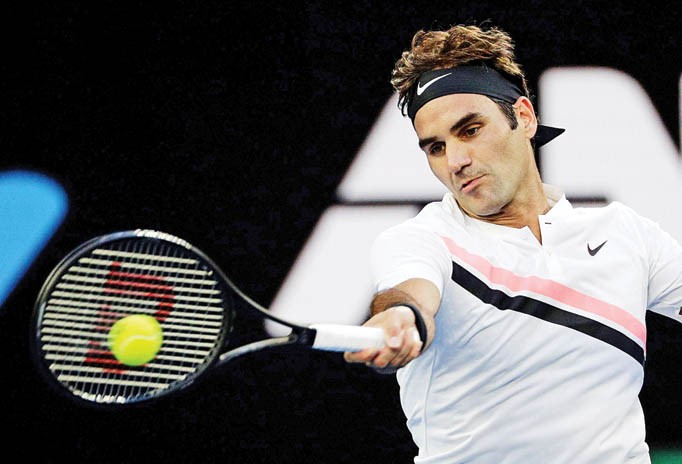
The Swiss maestro is now the first male player to hit the 20 major mark, and has increased his lead at the summit to four, with World No 1 Rafael Nadal second at 16

Around the same time last year, the then 17th seed Roger Federer entered the Australian Open after a six-month layoff to just ease into a season that was being predicted to be a part of his swansong - if not the curtain call. He hadn’t won a major for five years, and perhaps was aiming for one last assault at Wimbledon, using the hard court season as the foundation.
12 months later, he has won three of the five Grand Slam titles, including the eighth Wimbledon that he had been coveting since 2012. With the sixth crown Down Under last week, Federer also jointly holds the most Australian Open titles.
One can no longer say that Federer has ‘turned back the clock’ when his dominance of the sport continues to extend, and the level of tennis he has showcased has often surpassed the Federer of 2004-2007.
When you own the greatest male tennis career of all time, the superlatives write themselves. And when you continue to extend that, there’s a collective block for tennis writers.
But as Federer continues to outdo himself, and history, let’s put his 20th Grand Slam title into perspective.
The Swiss is now the first male player to hit the 20 major mark, and has increased his lead at the summit to four, with World No 1 Rafael Nadal second at 16.
Over the past year or so, Federer has been by far and away the best player on the tour, even though he mightn’t have cracked the ATP top ranking owing to missing the 2017 clay season in its entirety.
However, after successfully defending the Australian Open crown, Federer could take the No 1 spot from Nadal, if he enters and wins the ATP 500 at Dubai later this month.
While the point mechanism in tennis means that the rankings are an accurate portrayal of where a player stands, Federer getting it in the near future -- and in turn becoming the oldest man to be the No 1 -- would be especially deserving.
So while getting the top ranking is the immediate incentive for Federer -- even if he might be downplaying it -- what else does the Swiss maestro have in store? Also, what does his dominance mean for the rest of the tour?
For Federer, the next major goal would be Wimbledon. As he cruised to his eighth crown at SW19 last year, on current form he is a shoo-in for a repeat, with Nadal struggling on grass for the past six years and both Novak Djokovic and Andy Murray still dealing with the aftershocks of their injuries.
That most of the younger chasing pack are struggling with injuries while Federer easing through major wins at 37 is a further testament to the Swiss’ longevity, and more importantly, his scheduling over the past year or so.
As things stand, Federer looks good for an assault on all non-clay titles, and might actually go a step further than last year.
While Nadal was predicted to struggle this year, considering his historical inability to have back-to-back strong seasons, Federer’s only likely challenge anywhere this season might come from Djokovic. This is especially true after the Next Gen, and other pretenders to the thrones, continue to disappoint at majors.
However, Djokovic at the Australian Open was his own pale shadow. Yes, he wasn’t going to come and retrace his peak right away, but his level of play -- even though he was outdone by the impressive Chung Hyeon -- shows that it will take him a lot of time to recover to a level where he is challenging for the big titles.
And so, both Roland Garros -- where he completed the career Grand Slam in 2016 -- and Wimbledon -- where he stopped Federer’s then bid for eighth title in 2014 and 2015 -- might be too soon for Djokovic to challenge for.
If the Serb successfully manages to ease himself into the season, and remains healthy, he should be targeting the post-Wimbledon North American hard court season, with perhaps a tilt at the US Open.
As discussed, it wouldn’t be a surprise if Nadal has a long layoff this year -- especially after Roland Garros. But he would be looking to the clay season to maintain his dominance there.
Murray hasn’t played since Wimbledon, while injury halted Stan Wawrinka’s run in Melbourne as well.
All circumstances point to a year of Federer dominance, and it would totally depend on his own body and how he ensures that he remains healthy enough, by scheduling properly.
The question over how long Federer will continue is reverberating, with the fact that he missed the customary reference to coming back ‘next year’ in the trophy awarding ceremony in Melbourne, particularly concerning the fans.
As things stand, with Federer comfortably atop the men’s tennis, there is absolutely no need for him to even consider hanging up the racket -- especially if he manages to stay healthy.
But then some might argue that there mightn’t be a better time for the most illustrious male tennis player of all time to bid adieu while winning majors -- and perhaps at the top of the ATP rankings -- all the while reaffirming his immortality.